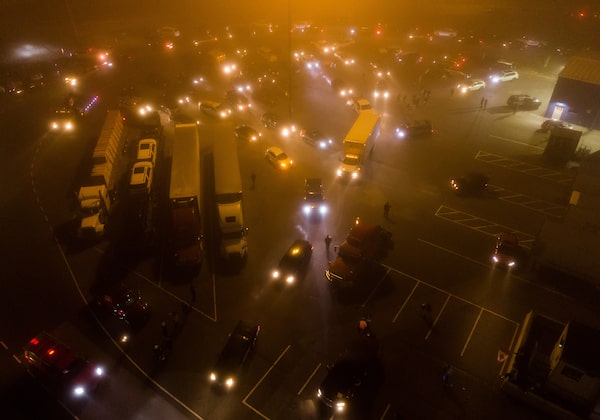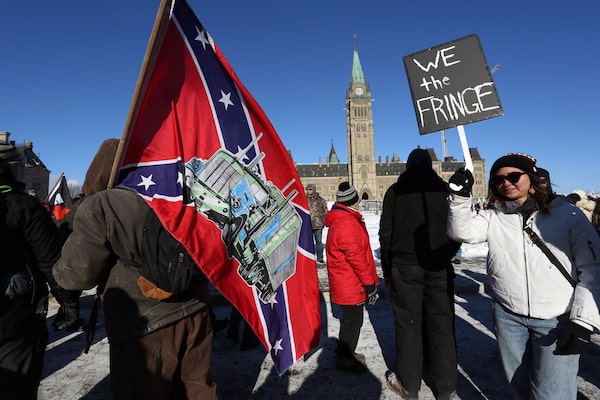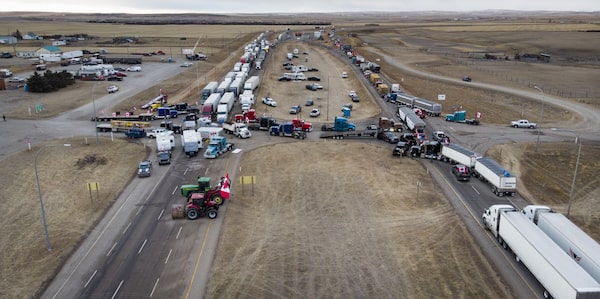The convoy protests officially arrived in Ottawa on Jan. 28, 2022, but the anger fuelling the movement had been simmering for nearly two years as Canada continued measures to curb the spread of COVID-19.
The convoy in Ottawa originally began as a backlash to new vaccine requirements for essential service providers crossing the U.S.-Canada border, but it transformed into a protest against all pandemic mandates and a referendum against Prime Minister Justin Trudeau and the mainstream media. Border crossings were blocked and solidarity demonstrations were mounted in cities across the country. In downtown Ottawa, the convoy disrupted the lives of residents and forced local businesses to close for the duration.
After three weeks, the protests culminated in Mr. Trudeau invoking the Federal Emergencies Act, which gave police expanded powers to stop protests at critical infrastructure sites and allowed banks to freeze personal and business accounts belonging to people suspected of financing the protests.
Ottawa police have said they are preparing for renewed protests ahead of the one-year anniversary of the demonstration. If vehicles are used once again to block downtown streets, Police Chief Eric Stubbs said they will take action to dismantle it “fairly quickly.” Here are 25 defining moments from the convoy protests.

Darryl Dyck/The Canadian Press
On Jan. 24, around a dozen trucks departed from Delta, B.C., headed to Ottawa to protest new federal vaccine requirements for cross-border essential workers. Supporters driving in their own vehicles joined for parts of the journey, while others donated millions of dollars through GoFundMe. The crowdfunding platform would release $1-million dollars to the convoy, but eventually froze the fundraiser and issued refunds to the majority of donors.

Melissa Tait/The Globe and Mail
Several wings of the convoy converged in a shopping mall plaza in Vaughan, Ont., north of Toronto on Jan. 27. Several hundred supporters, including their children, gathered for the trucks send-off.

Frank Gunn/The Canadian Press via AP
Standing on an overpass in Kanata, Ont., located just outside of Ottawa, supporters cheered for a convoy headed to Parliament Hill on Jan. 29.

DAVE CHAN/AFP via Getty Images, Justin Tang/The Canadian Press
On Jan. 29, between 8,000 and 15,000 protesters descended on Parliament Hill as hundreds of trucks and personal vehicles blocked Ottawa’s downtown streets. Honking and shouting could be heard across the downtown, even when inside condo and office buildings. Some protesters carried upside-down Canadian and Ontario flags; others brandished placards with obscenities directed at Prime Minister Justin Trudeau. Some of the signs were overtly hateful: a few contained swastikas, and a handful of protesters carried Confederate flags.
Some protesters were condemned for desecrating monuments by parking their cars on the National War Memorial, dancing on the Tomb of the Unknown Soldier and adding an anti-vaccine mandate sign to the Terry Fox statue near Parliament Hill.

Jeff McIntosh/The Canadian Press
As trucks jammed streets in downtown Ottawa, protesters in other parts of the country headed to border crossings in solidarity. In Coutts, Alta., about a three-hour drive southeast of Calgary, transport trucks, tractor-trailers and other vehicles blocked the busy U.S.-Canada border. The highway closures disrupted the small town of Coutts: school buses were cancelled, mail couldn’t be delivered and drivers were stuck in the gridlock.
Jeff McIntosh/The Canadian Press
Four days into protests at the U.S.-Canada border crossing in Coutts, Alta., demonstrators refused to dismantle the blockade, defying RCMP orders to disband. Although then-Alberta premier Jason Kenney condemned the blockades, he did publicly support pausing the vaccine mandate for cross-border truckers.
Justin Tang/The Canadian Press
After a week of disruptions in downtown Ottawa, then-Ottawa Police chief Peter Sloly announced on Feb. 4 that his officers would be implementing a hard-line approach as thousands more protesters were expected to arrive in the coming days. Ottawa residents, frustrated by non-stop honking, accused the police of abandoning them while taking a more lenient stance with protesters. Mr. Sloly eventually resigned on Feb. 15, two weeks after the protests began.
Justin Tang/The Canadian Press
Then-Ottawa city councillor Catherine McKenney embraced resident Pierrette Andrews during a community safety walk on Feb. 4. Ms. Andrews, who has lived in Centretown for 17 years, told Mx. McKenney of her difficulty breathing owing to truck exhaust fumes, and her struggles moving along sidewalks as snow-clearing operations were affected. Mx. McKenney became the public face of neighbourhood anger at the protests and an outspoken critic of city hall’s response.
Blair Gable/Reuters
Hundreds of counter-protesters gathered in the plaza in front of Ottawa City Hall on Feb. 5, the second weekend of the convoy blockades. They carried signs that read “Occupiers go home” and “No room for hate!” Downtown Ottawa residents had endured a week of blaring horns, blocked streets and taunts from aggressive protesters.
Nathan Denette/The Canadian Press
By Feb. 5, the convoy protests had spread across Canada, with solidarity demonstrations taking place in major cities on weekends. In Toronto, police cruisers, police SUVs and municipal buses blocked all vehicular traffic leading into Queen’s Park Circle, home of the provincial legislature building, and the nearby hospitals. However, protesters were still able to enter on foot.
Patrick Doyle/Reuters
In Ottawa’s Confederation Park on Feb. 6, protesters moved a wooden shack that was being used to give out free coffee and sandwiches after agreeing to its removal. The park had turned into a supply and staging area for the convoy, with barbecues, portable generators and ample supplies of wood.
Spencer Colby/The Globe and Mail
After more than nine days of protests, Ottawa Mayor Jim Watson declared a state of emergency on Feb. 6. That evening, police stepped up their attempt to choke off the protest’s supplies by removing fuel tankers from a support centre set up at the Raymond Chabot Grant Thornton Park, located in Ottawa’s east end.
Geoff Robins /AFP via Getty Images
The Ambassador Bridge connecting Windsor, Ont., and Detroit became another target of protesters. Trucks and other vehicles jammed the bridge on Feb. 8, cutting off a key trade route and threatening supply chains for a significant part of Canada.
Barbara Davidson/The Globe and Mail
By Feb. 10, a makeshift encampment had been erected at the Ambassador Bridge, featuring tents, couches, barbecues and a DJ. The children of some protesters played in a bouncy castle and on trampolines. The presence of children sparked criticism on social media, and complicated police plans to remove demonstrators.
Nathan Denette/The Canadian Press
After six days of protests, the blockade at Ambassador Bridge – North America’s busiest trade route – was cleared by police on Feb. 12. The day before, an Ontario Superior Court judge granted an injunction against protests at the bridge, ordering demonstrators to clear the area. But protesters remained until 8 a.m., when several hundred police officers arrived and the pickup trucks and cars eventually left the scene.
Chris Helgren/Reuters
As trucks and tents continued to clog several blocks of downtown Ottawa, fed-up residents staged a counter-protest on Feb. 13 about five kilometres from Parliament Hill to block a convoy of trucks trying to get downtown. A day later, on Feb. 14, Prime Minister Justin Trudeau invoked the Emergencies Act.
Gavin John/The Globe and Mail
On Feb. 15, the final holdouts at the border crossing in Coutts, Alta., abandoned their roadblock. That same day, four Alberta men were charged with plotting to murder RCMP officers. Investigators found two pipe bombs, 36,098 rounds of ammunition in plastic containers, gas masks, firearms and related accessories on a property belonging to one of the men accused.
Justin Tang/The Canadian Press
In downtown Ottawa on Feb. 16, people walked past a truck bearing a flag calling for Conservative MP Pierre Poilievre to become prime minister. Mr. Poilievre was one of the first politicians to publicly support the blockade.
Justin Tang/The Canadian Press
Three weeks into the blockade, the party vibes continued outside the Prime Minister’s Office on Feb. 17, with people dancing on a stage and music blaring. Two men soaked in an inflatable hot tub outside of the House of Commons entrance for MPs and parliamentary staff. Police set up a perimeter around downtown Ottawa, preventing more protesters from entering the area. Despite receiving a warning from police to leave immediately or risk consequences, including arrest and possible vehicle seizures, protesters remained defiant.
Justin Tang and Cole Burston/The Canadian Press
In one of the largest law-enforcement operations in Canadian history, police from across the country launched a massive sweep through downtown Ottawa on Feb. 19, arresting nearly 200 protesters and towing more than 50 vehicles. The crackdown was supported by armoured tactical vehicles, riot police and mounted police. A security perimeter remained around downtown, with almost 100 checkpoints in place. Only those who lived or worked in the area were granted access.
Patrick Doyle and Lars Hagberg/Reuters
On Feb. 20, police cleared out what remained of a protest camp on Coventry Road in Ottawa, which had become a logistics hub and meeting place.
With reports from Robert Fife, Marieke Walsh, Ian Bailey, Carrie Tait, Salmaan Farooqui, Jason Kirby, Janice Dickson, Jana Pruden, Erin Anderssen and The Canadian Press.
Convoy protests: More from The Globe and Mail
The Decibel podcast
A year after tens of thousands of people descended on Ottawa, some in their big-rig trucks, a lot has changed. Ottawa reporter Shannon Proudfoot discusses what some of the participants of the convoy think about it now, and whether another version of this protest could pop up again. Subscribe for more episodes.
By the time the trucks left downtown Ottawa, hundreds had been arrested, the local police chief quit and the federal government had invoked the Emergencies Act for the first time. The Decibel looks back at the tumultuous events. Subscribe for more episodes.
On the Emergencies Act
Texts, e-mails, documents: 30 hours leading up to Emergencies Act’s invocation
What we learned at Emergencies Act inquiry after six weeks of testimony
What the convoys left behind
They came. They idled. They left. What have convoy protesters been doing since they went home?
Gary Mason: Make no mistake – the Alberta government has been hijacked by the Freedom Convoy
Frank Graves and Michael Valpy: To avoid future convoy protests, we need an economy built on hope